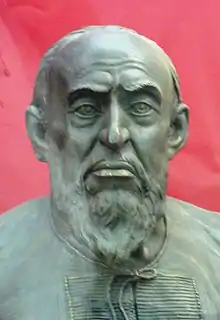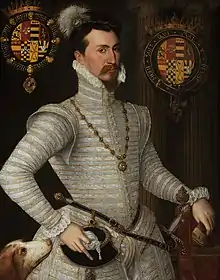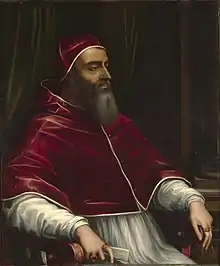1530s
The 1530s decade ran from January 1, 1530, to December 31, 1539.
| Millennium: | 2nd millennium |
| Centuries: | |
| Decades: | |
| Years: | |
| Categories: |
|
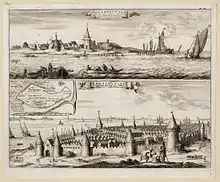
November 5, 1530: St. Felix's Flood destroys the city of Reimerswaal

July 26, 1533: Execution of Atahualpa.
Year 1530 (MDXXX) was a common year starting on Saturday (link will display the full calendar) of the Julian calendar.
Events
1530
January–June
- February 14 – Tangaxuan II, last cazonci of the Tarascan State, is executed by conquistador Nuño de Guzmán, ending the Tarascan State's independence from Spain.
- February 24 – Charles V is crowned emperor in Bologna, by Pope Clement VII.
- June 25 – The Augsburg Confession is presented to Charles V, Holy Roman Emperor.
July–December
- August 3 – Battle of Gavinana: Florence is captured by Spanish troops under Prince Philibert of Chalon (who is killed in the action). The Piagnon (followers of the memory of Girolamo Savonarola) are overthrown, ending the Siege of Florence, and the Medici are restored, in the person of the Pope's nephew Alessandro de' Medici.[1]
- September 15 – The miraculous portrait of Saint Dominic in Soriano appears in Soriano Calabro, Calabria.
- October 8 – A flood engulfs Rome.
- October 26 – The Knights of Malta are formed, when the Knights Hospitaller are given Malta by Charles V. They transfer the island capital from Mdina to Birgu.
- November 5 – St. Felix's flood devastates Zeeland: a large part of the Verdronken Land van Reimerswaal is lost leading to decline of the city of Reimerswaal.
- November 24 – Tabinshwehti succeeds his father Mingyi Nyo as king of the Toungoo dynasty, following the latter's death.
- December – Martim Afonso de Sousa's expedition sets out for the Americas from Portugal.
Date unknown
- The ducal palace of Celle is constructed in Germany.
- Austrian forces capture Esztergom, Hungary, and raid as far as Buda.
- Humayun starts to rule the Mughal Empire.
- Erasmus publishes A handbook on manners for children (De Civilitate Morum Puerilium Libellus), which becomes popular and widely translated.
- First complete edition of the 'Zürich Bible', Huldrych Zwingli's translation into German printed by Christoph Froschauer, is published.
1531
January–June
- January 26 – Lisbon, Portugal is hit by an earthquake, in which thousands die.[2]
- February 27 – Lutheran princes in the Holy Roman Empire form an alliance known as the Schmalkaldic League.
- February or March – Battle of Antukyah: Ahmad ibn Ibrahim al-Ghazi of the Adal Sultanate defeats the Ethiopian army.
- April – Battle of Puná: Francisco Pizarro defeats the island's native inhabitants.[3]
- April 12 – Askiya Musa is assassinated by his brothers in Songhai; Askia Mohammad Benkan is enthroned the same day.
- April 16 – The city of Puebla, Mexico, is founded.
- May – The third Dalecarlian rebellion in Sweden appears to be over, when the king accepts an offer made by the rebels, but violence flares up again the following year.
- June 24 – The city of San Juan del Río, Mexico, is founded.
July–December
- July 25 – The city of Santiago de Querétaro, Mexico is founded.
- August 22 – Battle of Obertyn: The Moldavians are defeated by Polish forces under Jan Tarnowski, allowing the Poles to recapture Pokucie.[4]
- August 26 – Comet Halley achieves its perihelion.[5]
- October 11 – Battle of Kappel: The forces of Zürich are defeated by the Catholic cantons. Huldrych Zwingli, the Swiss religious reformer, is killed.[6]
- October 28 – Battle of Amba Sel: Imam Ahmad ibn Ibrahim al-Ghazi again defeats the army of Dawit II, Emperor of Ethiopia. The southern part of Ethiopia thus falls under Imam Ahmad's control.
- November – Christian II`s invasion force arrives in Oslo.
- December 9 – The Virgin of Guadalupe first appears to Juan Diego at Tepeyac, Mexico City.
- December 12 – Mary, mother of Jesus, in the guise of Our Lady of Guadalupe, appears imprinted on the tilmàtli of Juan Diego Cuauhtlatoatzin, an Aztec convert to Catholicism, in Tepeyac near Mexico City.
Date unknown
- Andrea Alciato publishes the first part of his Emblemata.
- Conquistador Francisco de Montejo claims Chichen Itza as capital of Spanish-ruled Yucatán.
- The University of Sarajevo is founded by Gazi Husrev-beg.
- Kõpu Lighthouse is completed.
- An enormous drought in Henan province, China, coupled with a gigantic swarm of locusts in the summer, forces many in destitute agricultural communities to turn to cannibalism instead of dying by starvation.
- Charles V, Holy Roman Emperor abolishes the worst abuses of the encomienda system, by pressure of Bartolomé de las Casas.
- A witch-hunt is conducted in the town of Schiltach, Germany.
1532
January–June
- January 22 – São Vicente is established as the first permanent Portuguese settlement in Brazil.[7]
- March 18 – The English Parliament bans payment by the English Church to Rome.
- April – Battle of Quipaipan in Peru: Atahualpa wins the civil war in the Inca Empire, defeating his brother Huáscar.
- May 13 – Francisco Pizarro lands on the northern coast of Peru.[8]
- May 16 – Sir Thomas More resigns as Lord Chancellor of England.
- June 25 – Suleiman the Magnificent leads another invasion of Hungary.
July–December
- July 23 – The Nuremberg Religious Peace is granted to members of the Schmalkaldic League, granting them religious liberty.[9]
- August 13 – Union of Brittany and France: The Duchy of Brittany is absorbed into the Kingdom of France.[10]
- August 5–30 – Siege of Güns: The Ottoman army under Sultan Suleiman the Magnificent fails to take the city of Güns, and due to the incoming raining weather and reinforcements from Charles V to Vienna, Suleiman's army retreats.
- September 1 – Anne Boleyn is created Marquess of Pembroke by her fiancé, King Henry VIII of England.[11]
- November 16 – Francisco Pizarro and his men capture Inca emperor Atahualpa at Cajamarca, ambushing and slaughtering a large number of his followers, without loss to themselves. He subsequently offers a ransom of approximately $100 million in gold.
Date unknown
- The Prince is published, five years after the death of the author, Niccolò Machiavelli.[12]
- Pantagruel is published by François Rabelais.[13]
- Henry VIII of England grants the Thorne brothers a Royal Charter to found Bristol Grammar School.
- Stamford School is founded in England by William Radcliffe.
- The Paris Parlement has the city's beggars arrested "to force them to work in the sewers, chained together in pairs".[14]
- A possible date for the battle of the Maule between Incas and Mapuches, according to historian Osvaldo Silva.[15]
1533
January–June
- January 25 – King Henry VIII of England formally but secretly marries Anne Boleyn, who becomes his second queen consort.[16]
- January 26 – Thomas Audley, 1st Baron Audley of Walden, is appointed Lord Chancellor of England.
- March 30 – Thomas Cranmer becomes Archbishop of Canterbury.[17]
- April – The Statute in Restraint of Appeals in England declares the king to be the supreme sovereign and forbids judicial appeals to the papacy.
- May 23 – King Henry VIII of England's marriage with Catherine of Aragon is declared annulled by Archbishop Cranmer. Since Pope Clement VII had rejected Henry's petition for annulment in 1530, Catherine continues to believe herself Henry's wife until her death.
- June 1 – Cranmer crowns Anne Boleyn as queen consort of England, in Westminster Abbey.[18]
July–December
- July 11 – Henry VIII is excommunicated by Pope Clement VII, as is Archbishop Cranmer.[19]
- July 22 – Treaty of Constantinople between the Ottoman Empire and the Archduchy of Austria: Ferdinand I, King of the Romans, withdraws his claims to most of Hungary and János Szapolyai, voivode of Transylvania, becomes King of Hungary under the suzerainty of Suleiman the Magnificent, Sultan of the Ottoman Empire.
- July 26 – Sapa Inca Atahualpa is executed by garotte, at the orders of Francisco Pizarro in Cajamarca. The Spanish arrange for his younger brother Túpac Huallpa to be crowned as a successor, but he dies of smallpox soon afterwards.
- October 28 – The 14-year olds Henry, Duke of Orléans – the future King Henry II of France – and Catherine de' Medici are married at the Église Saint-Ferréol les Augustins in Marseille.
- November 15 – Francisco Pizarro arrives in Cusco, Peru.
- December 3 – Ivan IV succeeds his father Vasili III as Grand Prince of Muscovy at the age of three years.
- December – Hernando de Grijalva and his crew discover the uninhabited Revillagigedo Islands, off the Pacific coast of Mexico.
- December 21 (Feast of St Thomas the Apostle) – They discover Isla Santo Tomé, probably Socorro Island.
- December 28 – They discover Isla de los Inocentes, probably San Benedicto Island.[20]
Date unknown
- Paracelsus interprets the Bible in Appenzell.
- Pechenga Monastery is founded, in the far north of the Grand Duchy of Moscow.
- 1533–1534 – Sultan Suleiman the Magnificent makes the Ruthenian harem girl Roxelana his legal wife.
1534
January–June
- January 15 – The Parliament of England passes the Act Respecting the Oath to the Succession, recognising the marriage of Henry VIII and Anne Boleyn, and their children as the legitimate heirs to the throne.[21]
- February 23 – A group of Anabaptists, led by Jan Matthys, seize Münster, Westphalia and declare it The New Jerusalem, begin to exile dissenters, and forcibly baptize all others.
- c. March – The Portuguese crown divides Colonial Brazil into fifteen donatory captaincies.
- April 5 (Easter Sunday) – Anabaptist Jan Matthys is killed by the Landsknechte, who laid siege to Münster on the day he predicted as The Second Coming of Christ. His follower John of Leiden takes control of the city.
- April 7 – Sir Thomas More is confined in the Tower of London.
- May 10 – Jacques Cartier explores Newfoundland, while searching for the Northwest Passage.
- June 9 – Jacques Cartier is the first European to discover the Gulf of St Lawrence.
- June 23 – Copenhagen opens its gates to Count Christopher of Oldenburg, leading the army of Lübeck (and the Hanseatic League), nominally in the interests of the deposed King Christian II of Denmark. The surrenders of Copenhagen and, a few days later, of Malmö represent the high point of the Count's War for the forces of the League. These victories presumably lead the Danish nobility to recognize Christian III as King on July 4.[22][23]
- June 29 – Jacques Cartier discovers Prince Edward Island.
July–December
- July 4 – The Election of Christian III, as King of Denmark, takes place in the town of Rye.
- July 7 – The first known exchange occurs between Europeans and natives of the Gulf of St. Lawrence, in New Brunswick.
- August 15 – Ignatius of Loyola and six others take the vows that lead to the establishment of the Society of Jesus, in Montmartre (Paris).
- August 26 – Piero de Ponte becomes the 45th Grandmaster of the Knights Hospitaller.
- October 13 – Pope Paul III succeeds Pope Clement VII, as the 220th pope.[24]
- October 18 – Huguenots post placards all over France attacking the Catholic Mass, provoking a violent sectarian reaction.
- November 3–December 18 – The English Reformation Parliament passes the Act of Supremacy, establishing Henry VIII as supreme head of the Church of England.[21]
- December 6 – Over 200 Spanish settlers, led by conquistador Sebastián de Belalcázar, found what becomes Quito, Ecuador.
Date unknown
- Act for the Submission of the Clergy is confirmed by the Parliament of England, requiring churchmen to submit to the king, and forbidding the publication of ecclesiastical laws without royal permission.
- Manco Inca Yupanqui is crowned as Sapa Inca in Cusco, Peru by Spanish conquistador Francisco Pizarro, in succession to his brother Túpac Huallpa (d. October 1533).
- The Ottoman army under Suleiman the Magnificent captures the city of Baghdad from the Safavids.
- Cambridge University Press is given a Royal Charter by Henry VIII of England, and becomes the first of the privileged presses.
- Gargantua is published by François Rabelais.
- Martin Luther's translation of the complete Christian Bible into German is printed by Hans Lufft in Wittenberg, adding the Old Testament and Apocrypha to Luther's 1522 translation of the New Testament, and including woodcut illustrations.
- The first book in Yiddish is printed (in Kraków), Mirkevet ha-Mishneh, a Tanakh concordance by Rabbi Asher Anchel, translating difficult phrases in biblical Hebrew.[25]
1535
January–June
- January 18 – Lima, Peru, is founded by Francisco Pizarro, as Ciudad de los Reyes.[26]
- February 27 – George Joye publishes his Apologye in Antwerp, to clear his name from the accusations of William Tyndale.
- March – English forces under William Skeffington storm Maynooth Castle in Ireland, the stronghold of Thomas FitzGerald, 10th Earl of Kildare.[27]
- March 10 – Fray Tomás de Berlanga discovers the Galápagos Islands, when blown off course en route to Peru.
- May 4 – The first of the English Carthusian Martyrs is executed.
- May 10 – Amsterdam: A small troop of Anabaptists, led by the minister Jacob van Geel, attacks the city hall, in an attempted coup to seize the city. In the counter-attack by the city's militia, the burgemeester, Pieter Colijns, is killed by the rebels.[28] In another incident this year in Amsterdam, seven men and five women walk nude in the streets; and Anabaptists rebel in other cities of the Netherlands.
- May 19 – French explorer Jacques Cartier sets sail for his second voyage to North America with three ships, 110 men, and Chief Donnacona's two sons (taken by Cartier during his first voyage).
- May 20 – William Tyndale is arrested in Antwerp for heresy, in relation to his Bible translation,[29] and imprisoned in Vilvoorde.
- June 1 – The Conquest of Tunis by Charles V, Holy Roman Emperor, begins with the destruction of Barbarossa's fleet. Following the eventual capture of the city from the Ottoman Empire, around 30,000 inhabitants are massacred.
- June 8 – Battle of Bornholm: Combined Swedish and Danish fleets defeat the Hanseatic navy.
- June 22 – Cardinal John Fisher, Bishop of Rochester, is executed for his refusal to swear an oath of loyalty to King Henry VIII of England.[21]
- June 24 – Münster Rebellion: The Anabaptist state of Münster is conquered and disbanded.
July–December
- July 6 – Sir Thomas More, author of Utopia and one time Lord Chancellor of England, is executed for treason, after refusing to recognize King Henry VIII as head of the English Church, and separate from the Roman Catholic Church.[27]
- July 15 – Archdeacon Charles Reynolds (cleric), envoy to James V, Charles V, and Pope Paul III, is buried in Rome. He died of malaria while lobbying for the excommunication of King Henry VIII for heresy.
- October 2 – Jacques Cartier reaches the island in the Saint Lawrence River, that eventually becomes Montreal.
- October 4 – The first complete English-language Bible is printed in Antwerp, with translations by William Tyndale and Myles Coverdale.
- December – Manco Inca Yupanqui, nominally Sapa Inca, is imprisoned by the Spanish Conquistadors of Peru.
Date unknown
- Mughal Emperor Humayun gives battle to Bahadur Shah of Gujarat.
- Spanish forces abandon the second attempted conquest of Yucatán.
- The earliest (partially) preserved printed book in Estonian, a Catechism with a translation by Johann Koell from the Middle Low German Lutheran text of Simon Wanradt, is printed by Hans Lufft in Wittenberg, for use in Tallinn.[30]
- Suleiman the Magnificent begins the rebuilding of the walls around Jerusalem.[31]
- Paracelsus visits Bad Pfäfers.
1536
January–June
- January – King Henry VIII of England suffers a leg injury during a jousting tournament.
- January 6 – The Colegio de Santa Cruz de Tlatelolco, the oldest European school of higher learning in the Americas, is established by Franciscans in Mexico City.
- January 22 – John of Leiden, Bernhard Knipperdolling and Bernhard Krechting are executed in Münster for their roles in the Münster Rebellion.
- February 2 – Spaniard Pedro de Mendoza founds Buenos Aires, Argentina.
- February 18 – A Franco-Ottoman alliance exempts French merchants from Ottoman law and allows them to travel, buy and sell throughout the sultan's dominions, and to pay low customs duties on French imports and exports. The compact is confirmed in 1569.
- February 25 – Tyrolean Anabaptist leader Jacob Hutter, founder of the Hutterites, is burned at the stake in Innsbruck for heresy.
- March
- The first edition of John Calvin's Institutes of the Christian Religion, a seminal work of Protestant systematic theology, is published in Basel.[32]
- The Italian War of 1536–1538 resumes between Francis I of France and Charles V, Holy Roman Emperor. Francis seizes control of Savoy, and captures Turin. Charles triumphally enters Rome, following the Via Triumphalis, and delivers a speech before the Pope and College of Cardinals, publicly challenging the king of France to a duel.
- April – An Acte for Laws & Justice to be ministred in Wales in like fourme as it is in this Realme further incorporates the legal system of Wales into that of England.[33]
- April 6 – Count's Feud: Malmø surrenders to King Christian III of Denmark.
- April 14 – The Reformation Parliament in England passes an Act for the Dissolution of the Monasteries.[21] Religious houses closed as part of Henry VIII's dissolution include: Basingwerk Abbey, Bourne Abbey, Brinkburn Priory, Buildwas Abbey, Cartmel Priory, Dorchester Abbey, Dore Abbey, Haltemprice Priory, Keldholme Priory and Tintern Abbey.
- April 30 – The Inquisition is implemented in Portugal.
- May 2 – Anne Boleyn, second queen of Henry VIII of England, is arrested on the grounds of incest, adultery and treason.
- May 6 – Incan emperor Manco Inca Yupanqui, having on April 18 escaped from imprisonment in Cuzco, begins his revolt against his captors, when his army begins the 10-month Siege of Cuzco against a garrison of Spanish conquistadors and Indian auxiliaries, led by Hernando Pizarro.
- May 14 – Thomas Cranmer declares Henry VIII of England's marriage to Anne Boleyn to be null and void.[34]
- May 30 – Henry VIII of England marries Jane Seymour.[35]
- June 24 – San Juan Bautista del Teul is founded by Cristóbal de Oñate in New Spain.
- June 26 – Spanish navigator Andrés de Urdaneta and a few companions arrive in Lisbon from the Maluku Islands, completing a westward circumnavigation which began with the Loaísa expedition of 1525.
- June 27 – San Pedro Sula is founded by Pedro de Alvarado in Honduras.
July–December
- July 29 – Count's Feud ends when Copenhagen surrenders to King Christian III of Denmark. On August 6 he marches into the city and on August 12 arrests the country's bishops, thus consolidating the Protestant Reformation in Denmark.
- August 5 – Guelders Wars: Battle of Heiligerlee – Danish allies of Charles II, Duke of Guelders, under command of Meindert van Ham, are defeated by Habsburg forces under Georg Schenck van Toutenburg in the Low Countries.
- August 10 – Francis III, Duke of Brittany, Dauphin of France, dies having caught a chill after a game of tennis which had developed into a fever; under torture Sebastiano de Montecuccoli, his Italian secretary, confesses to poisoning him and is brutally executed on October 7. Francis' younger brother, Henry, Duke of Orléans, succeeds as heir to the kingdom.
- October 1–December 5 – The Pilgrimage of Grace, a rebellion in England against Henry VIII's church reforms,[21] beginning as the Lincolnshire Rising and spreading to Yorkshire, from where it is led by Robert Aske.
- October 6 – English Bible translator William Tyndale is burned at the stake in Vilvoorde, Flanders.[21]
Date unknown
- Battle of Reynogüelén: Spanish conquistadors defeat a group of Mapuches in Chile, during the expedition of Diego de Almagro.
- Battle of Un no Kuchi: Takeda Family forces defeat Hiraga Genshin.
1537
January–June
- January
- Bigod's Rebellion, an uprising by Roman Catholics against Henry VIII of England, is crushed.
- Battle of Ollantaytambo: Emperor Manco Inca Yupanqui is victorious against the Spanish and their Indian allies led by Hernando Pizarro.
- March – Diego de Almagro successfully charges Manco Inca's siege of Cuzco, thereby saving his antagonists, the Pizarro brothers.
- March 12 – Recife is founded by the Portuguese, in Brazil.
- April – Spanish conquest of the Muisca: Bacatá, the main settlement of the Muisca Confederation, is conquered by Gonzalo Jiménez de Quesada, effectively ending the Confederation in the Colombian Eastern Andes.[36]
- April 1 – The Archbishop of Norway Olav Engelbrektsson flees from Trondheim to Lier, Belgium.
- June 2 – Pope Paul III publishes the encyclical Sublimis Deus, which declares the natives of the New World to be rational beings with souls, who must not be enslaved or robbed.
- June 23 – Siege of Hamar ends with the arrest of Bishop Mogens Lauritssøn, and the Catholic rebellion is definitively ended in Norway.
July–December
- July – Rodrigo Orgóñez occupies and sacks the Inca center of Vitcos but Manco Inca Yupanqui escapes and establishes the independent Neo-Inca State elsewhere in Vilcabamba, Peru.
- August 15 – Asunción is founded by Juan de Salazar de Espinosa.
- August 25 – The Honourable Artillery Company, the oldest surviving regiment in the British Army, and the second most senior, is formed.
- August-September – The Ottoman Empire fails to capture Corfu, but this year does conquer the islands of Paros and Ios.
- October 15 – Following the baptism of her son, the future Edward VI of England, Jane Seymour begins suffering from puerperal fever.[37]
Date unknown
- The Spaniards bring the potato to Europe.
- Kiritimati (Acea or "Christmas Island") is probably sighted by the Spanish mutineers from Hernando de Grijalva's expedition.
- Bangalore is first mentioned.
- Dissolution of the monasteries in Norway: Religious buildings dissolved by Christian III include: Bakke Abbey, Munkeby Abbey, Tautra Abbey, Nidarholm Abbey, Gimsøy Abbey and Utstein Abbey.
- Publication of complete Bible translations into English, both based on Tyndale's:
Ongoing
- Dissolution of the monasteries in England: Religious buildings dissolved by Henry VIII of England include: Bisham Priory, Bridlington Priory, Castle Acre Priory, Chertsey Abbey, Furness Abbey, London Charterhouse and Valle Crucis Abbey.
January–June
- February 24 – Treaty of Nagyvárad: Peace is declared between Ferdinand I, future Holy Roman Emperor and the Ottoman Empire. John Zápolya is recognized as King of Hungary (Eastern Hungarian Kingdom), while Ferdinand retains the northern and western parts of the Kingdom, and is recognized as heir to the throne.[38]
- April 26 – Battle of Las Salinas: Almagro is defeated by Francisco Pizarro, who then seizes Cusco.[39]
- June 18 – Truce of Nice: Peace is declared between Emperor Charles V and Francis I of France.
- June 19 – Dissolution of the Monasteries in England: The newly founded Bisham Abbey is dissolved.
July–December
- August 6 – Bogotá, Colombia is founded by Gonzalo Jiménez de Quesada.
- September 28 – Battle of Preveza: The Ottoman fleet of Suleiman the Magnificent, under the command of Hayreddin Barbarossa, defeats the Holy League of Emperor Charles V, under the command of Andrea Doria.[40]
- September 29–October 6 – The last significant volcanic eruption in the Phlegraean Fields of Italy creates Monte Nuovo.
- October 28 – The first university of the New World, the Universidad Santo Tomás de Aquino, is founded on the island of Hispaniola.
- November 6 – The end of the Siege of Diu as the Gujarat and Ottoman forces withdraw from the Portuguese-held city.
- November 30
- Sucre, Bolivia, is founded under the name Ciudad de la Plata de la Nueva Toledo.
- Dissolution of the Monasteries in England: Byland Abbey is dissolved.
- December 17 – Pope Paul III confirms the excommunication of Henry VIII of England from the Roman Catholic church.[41]
Date unknown
- Michelangelo starts work on the Piazza del Campidoglio on the Capitoline Hill in Rome.
- The first in a decade-long series of severe famines and epidemics sweep central and southeastern China during the Ming dynasty, made worse by a decision of 1527 to cut back on the intake of grain quotas for granaries.
- In China, a tsunami floods over the seawall in Haiyan County of Zhejiang province, inundating fields with saltwater, ruining many acres of crops. This drives up the price of foodstuffs, and many are forced to live off of tree bark and weeds (as Wang Wenlu states in his writing of 1545).
- Paracelsus visits Villach.
1539
January–June
- January – Toungoo–Hanthawaddy War – Battle of Naungyo, Burma: The Toungoos decisively defeat the Hanthawaddys.
- January 12 – Treaty of Toledo: Charles V, Holy Roman Emperor (and Charles I of Spain) and Francis I of France agree to make no further alliances with England. The treaty comes after Henry VIII of England's split with Rome and Pope Paul III.
- January 14 – Spain annexes Cuba.
- February 9 – The first horse race is held at Chester Racecourse, the oldest in use in England.[42]
- March – Canterbury Cathedral surrenders, and reverts to its previous status of 'a college of secular canons'.
- May 30 – Hernando de Soto lands at Tampa Bay, Florida with 600 soldiers, with the goal of finding gold. He also introduces pigs into North America.
- May – The Six Articles, an Act of the Parliament of England, reaffirms certain Catholic principles in Henry VIII's Church of England.[43]
- June 26 – Battle of Chausa in modern-day Buxar, India: Sher Shah Suri defeats the Mughal emperor, Humayun (Sher Shah goes on to form the Sur Empire, and take control of nearly all Mughal territory).
July–December
- August 15 – King Francis I of France issues the Ordinance of Villers-Cotterêt, that places the whole of France under the jurisdiction of the royal law courts, and makes French the language of those courts, and the official language of legal discourse.
- September 7 – Guru Angad Dev becomes the second Guru of the Sikhs.
- October 4 – Henry VIII contracts to marry Anne of Cleves.[44]
- November 1 – Joachim II Hector introduces Lutheranism in the Margraviate of Brandenburg, becoming the second Prince-Elector after the Prince-Elector of Saxony to turn Protestant.
- November 26 – Abbot Marmaduke Bradley and 31 monks sign the deed surrendering Fountains Abbey to the English Crown. [45]
Undated
- Protestant Reformation
- Lutheranism is forcibly introduced into Iceland, despite the opposition of Bishop Jón Arason.
- Beaulieu Abbey, Bolton Abbey, Colchester Abbey, Newstead Abbey, St Albans Abbey, St Mary's Abbey, York and Hartland Abbey (the last) fall prey to the Dissolution of the Monasteries in England.
- The first edition of the Calvinist Genevan Psalter is published.
- In Henan province, China, a severe drought with swarms of locusts is made worse, by a major epidemic outbreak of the plague.
- The first printing press in North America is set up in Mexico City.[46]
- Teseo Ambrogio's Introductio in Chaldaicam lingua, Syriaca atq Armenica, & dece alias linguas, published in Pavia, introduces several Middle Eastern languages to western Europe for the first time.
Births
1530
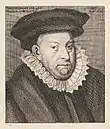
Sir Thomas Bromley
- January 1 – Thomas Bromley, English lord chancellor (d. 1587)
- January 5 – Gaspar de Bono, Spanish monk of the Order of the Minims (d. 1571)
- January 31 – Ōtomo Sōrin, Japanese Christian Daimyō (d. 1587)
- February 17 – Louis III, Count of Löwenstein (d. 1611)
- February 18 – Uesugi Kenshin, Japanese samurai and warlord (d. 1578)
- February 26 – David Chytraeus, German historian and theologian (d. 1600)
- March 11 – Johann Wilhelm, Duke of Saxe-Weimar (d. 1573)
- May 5 – Gabriel, comte de Montgomery, French nobleman (d. 1574)
- May 7 – Louis I de Bourbon, Prince de Condé, French Protestant general (d. 1569)
- June 17 – François de Montmorency, French nobleman (d. 1579)
- June 20 – Johannes Schenck von Grafenberg, German physician (d. 1598)
- July 3 – Claude Fauchet, French historian (d. 1602)
- August 1 – Daniel, Count of Waldeck (d. 1577)
- August 11 – Ranuccio Farnese, Italian prelate (d. 1565)
- August 14 – Giambattista Benedetti, Italian mathematician and physicist (d. 1590)
- August 25 – Ivan IV of Russia (d. 1584)[47]
- September 30 – Geronimo Mercuriale, Italian philologist and physician (d. 1606)
- October 1 – Walter Aston, English politician (d. 1589)
- October 21 – Jacques Jonghelinck, Flemish sculptor (d. 1606)
- October 30 – Charles d'Angennes de Rambouillet, Roman Catholic cardinal (d. 1587)
- November 1 – Étienne de La Boétie, French judge and writer (d. 1563)
- November 6 – Josias Simler, Swiss scholar (d. 1576)
- December 1 – Bernardino Realino, Italian Jesuit (d. 1616)
- December 5 – Nikolaus Selnecker, German musician (d. 1592)
- date unknown
- Julius Caesar Aranzi, Italian anatomist (d. 1589)
- Vincenza Armani, Italian actress (d. 1569)
- Christopher Báthory, Prince of Transylvania (d. 1581)
- Jean Bodin, French jurist (d. 1596)
- Pey de Garros, Provençal poet (d. 1585)
- Wawrzyniec Grzymała Goślicki, Polish bishop, political thinker and philosopher (d. 1607)
- Thomas Hoby, English diplomat and translator (d. 1566)
- Kōriki Kiyonaga, Japanese daimyō in the Azuchi-Momoyama and Edo periods (d. 1608)
- Jan Kochanowski, Polish writer (d. 1584)
- Jean Nicot, French diplomat and scholar (d. 1606)
- Richard Tarlton, English actor (d. 1588)
- Mordecai Yoffe, Bohemian author of Levush Malkhut (d. 1612)
- Anastasia Romanovna, Russian Tsaritsa (d. 1560)
- probable
- Moses Isserles, Polish rabbi and Talmudist (d. 1572)
- Claude Le Jeune, French composer (d. 1600)
- Gráinne O'Malley, Irish ruler (d. 1603)
- Teodora Ginés, Dominican musician and composer (d. 1598)
- Shane O'Neill, Irish chieftain and rebel (d. 1567)
- Turlough Luineach O'Neill, Irish chieftain of Tyrone (d. 1595)
- Jöran Persson, Swedish politician (d. 1568)
- Nicholas Sanders, English Catholic propagandist (d. 1581)
- Ruy López de Segura, Spanish priest (d. 1580)
1531

Maria of Austria, Duchess of Jülich-Cleves-Berg

Anna d'Este
- January 26 – Jens Bille, Danish son of Claus Bille and Lisbeth Ulfstand (d. 1575)
- April 6 – Wolfgang, Duke of Brunswick-Grubenhagen (d. 1595)
- May 15 – Maria of Austria, Duchess of Jülich-Cleves-Berg, daughter of Emperor Ferdinand I (d. 1581)
- May 20 – Viceroy Thado Minsaw of Ava (d. 1584)
- June 1 – János Zsámboky, Hungarian scholar (d. 1584)
- July 17 – Antoine de Créqui Canaples, French Catholic cardinal (d. 1574)
- July 22 – Leonhard Thurneysser, German scholar and quack at the court of John George, Elector of Brandenburg (d. 1595)
- September 2 – Francesco Cattani da Diacceto, Bishop of Fiesole (d. 1595)
- September 4 – Hans Fugger, German businessman (d. 1598)
- September 14 – Philipp Apian, German mathematician and medic (d. 1589)
- Late September – Henry Stanley, 4th Earl of Derby, English noble and diplomat (d. 1594)
- October 7 – Scipione Ammirato, Italian historian (d. 1601)
- October 12 – Jacques de Savoie, 2nd Duc de Nemours (d. 1585)
- October 25 – Matthew Wesenbeck, Belgian jurist (d. 1586)
- October 27 – Herbert Duifhuis, Dutch minister (d. 1581)
- November 14 – Richard Topcliffe, English torturer (d. 1604)[48]
- November 16 – Anna d'Este, duchess consort of Nemours (d. 1607)
- November 18 – Roberto di Ridolfi, Italian conspirator against Elizabeth I of England (d. 1612)
- November 29 – Johannes Letzner, German Protestant priest and historian (d. 1613)
- December – Hendrick van Brederode, Dutch noble (d. 1568)
- December 6 – Vespasiano I Gonzaga, Italian noble and diplomat (d. 1591)
- December 9 – Şehzade Cihangir, Ottoman prince (d. 1553)
- December 10 – Henry IX, Count of Waldeck (d. 1577)
- date unknown
1532
- January 21[49] – Ludwig Helmbold, German classical singer (d. 1598)
- February 14 – Richard Lowther, English soldier and official (d. 1607)
- February 19 – Jean-Antoine de Baïf, French poet and member of the Pléiade (d. 1589)[50]
- March 20 – Juan de Ribera, Spanish Catholic archbishop (d. 1611)
- March 25 – Pietro Pontio, Italian music theorist and composer (d. 1596)
- April 13 – Frederick of Denmark, Prince-bishop (d. 1556)
- April 21 – Martin Schalling the Younger, German theologian (d. 1608)
- April 23 – Anna Marie of Brunswick-Lüneburg, Duchess of Prussia (d. 1568)
- April 24 – Thomas Lucy, English politician (d. 1600)
- June 6 – Giulio Antonio Santorio, Italian Catholic cardinal (d. 1602)
- June 7 – Amy Robsart, wife of Robert Dudley, 1st Earl of Leicester (d. 1560)
- June 13 – Countess Palatine Helena of Simmern, countess consort of Hanau-Münzenberg (1551-1561) (d. 1579)
- June 16 – Francis Coster, Brabantian Jesuit theologian, author (d. 1619)
- June 24
- Robert Dudley, 1st Earl of Leicester, English politician (probable;[51] d. 1588)
- William IV, Landgrave of Hesse-Kassel, German Protestant leader (d. 1592)
- July 1 – Marino Grimani, Doge of Venice (d. 1605)
- July 12 – Mechthild of Bavaria, German duchess (d. 1565)
- July 25 – Alphonsus Rodriguez, Spanish Jesuit lay brother and saint (d. 1617)
- August 14 – Archduchess Magdalena of Austria, Member of the House of Habsburg (d. 1590)
- October 4 – Francisco de Toledo, Spanish Catholic cardinal (d. 1596)
- October 30 – Yuri of Uglich, Prince of Uglich (d. 1563)
- November 16 – Clara of Brunswick-Wolfenbüttel, Abbess of Gandersheim, later Duchess of Brunswick-Grubenhagen (d. 1595)
- November 22 – Anne of Denmark, Electress of Saxony (d. 1585)
- November 28 – Bartholomäus Ringwaldt, German poet and theologian (d. 1599)
- December 7 – Louis I, Count of Sayn-Wittgenstein (d. 1605)
- December 20
- December 26 – Guilielmus Xylander, German classical scholar (d. 1576)
- date unknown
- Robert Abercromby, Scottish Jesuit missionary (d. 1613)
- William Allen, English cardinal (d. 1594)
- Hernando Franco, Spanish composer (d. 1585)[52]
- Luís Fróis, Portuguese missionary (d. 1597)
- Pedro Sarmiento de Gamboa, Spanish explorer (d. 1592)
- John Hawkins, English navigator (d. 1595)
- Étienne Jodelle, French dramatist and poet (d. 1573)
- Ralph Lane, English explorer (d. 1603)
- Henry Percy, 8th Earl of Northumberland (d. 1585)
- Thomas Norton, English lawyer (d. 1584)
- Tulsidas, medieval Hindi poet and philosopher (d. 1623)
- Flavio Orsini, Italian Catholic cardinal (d. 1581)
- probable
- Sofonisba Anguissola, Italian portrait painter (d. 1625)
- Archibald Campbell, 5th Earl of Argyll, Scottish politician (d. 1575)
- Orlande de Lassus, Flemish composer (d. 1594)
1533

Queen Elizabeth I

Catherine of Austria, Queen of Poland
- January 2 – Johann Major, German poet and theologian (d. 1600)
- January 3 – Jerónimo Bautista Lanuza, Spanish friar, bishop and writer (d. 1624)
- January 6 – Timotheus Kirchner, German theologian (d. 1587)
- January 28 – Paul Luther, German scientist (d. 1593)
- February 5 – Andreas Dudith, Croatian-Hungarian nobleman and diplomat (d. 1589)
- February 9 – Shimazu Yoshihisa, Japanese samurai (d. 1611)
- February 16 – Gianfrancesco Gambara, Italian Catholic cardinal (d. 1587)
- February 28 – Michel de Montaigne, French essayist (d. 1592)[53]
- March 10 – Francesco III Gonzaga, Duke of Mantua (d. 1550)
- April 5 – Giulio della Rovere, Italian Catholic cardinal (d. 1578)
- April 8 – Claudio Merulo, Italian composer and organist (d. 1604)[54]
- April 24 – William I of Orange (d. 1584)
- May 2 – Philip II, Duke of Brunswick-Grubenhagen (d. 1596)
- June 30 – Martín de Rada, Spanish missionary (d. 1578)
- July 10 – Antonio Possevino, Italian diplomat (d. 1611)
- August 2 – Theodor Zwinger, Swiss scholar (d. 1588)
- August 7
- September 5 – Jacopo Zabarella, Italian philosopher (d. 1589)
- September 7 – Queen Elizabeth I of England, daughter of King Henry VIII of England (d. 1603)[55]
- September 15 – Catherine of Austria, Queen of Poland (d. 1572)
- September 27 – Stefan Batory, King of Poland (d. 1586)
- October 9 – Henry V, Burgrave of Plauen (d. 1568)
- October 12 – Asakura Yoshikage, Japanese ruler (d. 1573)
- October 14 – Anna of Mecklenburg, duchess consort of Courland (1566-1587) (d. 1602)
- November 22 – Alfonso II d'Este, Duke of Ferrara, Italian noble (d. 1597)
- December 13 – King Eric XIV of Sweden (d. 1577)[56]
- date unknown – Eknath, Indian Marathi saint (d. 1599)
- probable
- Amina, Queen of Zazzua (d. 1610)
- Cornelis Cort, Dutch engraver (d. 1578)
- David Rizzio, Italian secretary of Mary, Queen of Scots (k. 1566)
1534
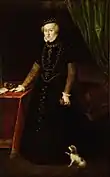
Archduchess Eleanor of Austria
- January 6 – Pavao Skalić, Croatian encyclopedist, Renaissance humanist and adventurer (d. 1575)
- February 5 – Giovanni de' Bardi, Italian writer, composer and soldier (d. 1612)
- February 10 – Song Ikpil, Korean scholar (d. 1599)
- March 19 – José de Anchieta, Spanish Jesuit missionary in Brazil (d. 1597)
- April 18 – William Harrison, English clergyman (d. 1593)
- June 15 – Henri I de Montmorency, Marshal of France (d. 1614)
- June 23 – Oda Nobunaga, Japanese warlord (d. 1582)
- July 1 – King Frederick II of Denmark (d. 1588)
- July 3 – Myeongjong of Joseon, ruler of Korea (d. 1567)
- July 18 – Zacharius Ursinus, German theologian (d. 1583)
- August 29 – Nicholas Pieck, Dutch Franciscan friar and martyr (d. 1572)
- September 24 – Guru Ram Das, fourth Sikh Guru (d. 1581)
- October 4 – William I, Count of Schwarzburg-Frankenhausen (d. 1597)
- October 18 – Jean Passerat, French writer (d. 1602)
- November 2 – Archduchess Eleanor of Austria (d. 1594)
- November 6 – Joachim Camerarius the Younger, German scientist (d. 1598)
- November 17 – Karl I, Prince of Anhalt-Zerbst, German prince (d. 1561)
- November 26 – Henry Berkeley, 7th Baron Berkeley (d. 1613)
- December 16 – Lucas Osiander the Elder, German pastor (d. 1604)
- December 16 – Hans Bol, Flemish artist (d. 1593)
- date unknown
- Lodovico Agostini, Italian composer (d. 1590)
- Isaac Luria, Jewish scholar and mystic (d. 1572)
- Henry Herbert, 2nd Earl of Pembroke, statesman of the Elizabethan era (d. 1601)[57]
- Paul Skalić, Croatian encyclopedist, humanist and adventurer (d. 1573)
- Joan Waste, English Protestant martyr (d. 1556)
- Lautaro, Mapuche warrior (d. 1557)
1535
_c_1565.jpg.webp)
Katarina Stenbock
- February 11 – Pope Gregory XIV (d. 1591)[58]
- January 7 – Edward Stafford, 3rd Baron Stafford, English baron (d. 1603)
- February 24 – Eléanor de Roucy de Roye, French noble (d. 1564)
- February 27 – Min Phalaung, Burmese monarch (d. 1593)
- February 28 – Cornelius Gemma, Dutch astronomer and astrologer (d. 1578)
- March 10 – William of Rosenberg, High Treasurer and High Burgrave of Bohemia (d. 1592)
- March 23 – Sophie of Brandenburg-Ansbach, princess of Brandenburg-Ansbach (d. 1587)
- May 31 – Alessandro Allori, Italian painter (d. 1607)
- June 2 – Pope Leo XI (d. 1605)[59]
- June 18 – Jakub Krčín, Czech architect (d. 1604)
- June 21 – Leonhard Rauwolf, German physician and botanist (d. 1596)
- June 24 – Joanna of Austria, Princess of Portugal (d. 1573)
- July 4 – William the Younger, Duke of Brunswick-Lüneburg (d. 1592)
- July 21 – García Hurtado de Mendoza, 5th Marquis of Cañete, Royal Governor of Chile (d. 1609)
- July 22 – Katarina Stenbock, queen of Gustav I of Sweden (d. 1621)
- August 21 – Shimazu Yoshihiro, Japanese samurai and warlord (d. 1619)
- September 6 – Emanuel van Meteren, Flemish historian (d. 1612)
- September 18 – Henry Brandon, 2nd Duke of Suffolk (d. 1551)
- October 16 – Niwa Nagahide, Japanese warlord (d. 1585)
- November 9 – Nanda Bayin, King of Burma (d. 1600)
- December 12 – Gilbert Génébrard, Roman Catholic archbishop (d. 1597)
- December 28 – Martin Eisengrein, German theologian (d. 1578)
- date unknown
1536
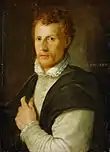
Cornelis Cort
- January 22 – Philibert, Margrave of Baden-Baden (d. 1569)
- February 2
- February 12 – Leonardo Donato, Doge of Venice (d. 1612)
- February 24 – Pope Clement VIII (d. 1605)[60]
- March 6 – Santi di Tito, Italian painter (d. 1603)
- March 10 – Thomas Howard, 4th Duke of Norfolk, English politician (d. 1572)
- March 31 – Ashikaga Yoshiteru, Japanese shōgun (d. 1565)
- April 8 – Barbara of Hesse (d. 1597)
- May 3 – Stephan Praetorius, German theologian (d. 1603)
- May 13 – Jacobus Pamelius, Belgian bishop (d. 1587)
- August 10 – Caspar Olevian, German Protestant theologian (d. 1587)
- August 14 – René, Marquis of Elbeuf (d. 1566)
- October 18 – William Lambarde, English antiquarian, writer on legal subjects, politician (d. 1601)
- October 21 – Joachim Ernest, Prince of Anhalt (d. 1586)
- October 28 – Felix Plater, Swiss physician (d. 1614)
- November 11 – Marcantonio Memmo, Doge of Venice (d. 1615)
- November 22 – Johann VI, Count of Nassau-Dillenburg (d. 1606)
- December 26 – Yi I, Korean Confucian scholar (d. 1584)
- December 29 – Henry VI, Burgrave of Plauen (d. 1572)
- date unknown
- Juan de Fuca, Greek maritime pilot (d. 1602)
- Jeong Cheol, Korean administrator and poet (d. 1593)
- Thomas Sackville, 1st Earl of Dorset, English statesman and poet (d. 1608)
- Leonor de Cisneros, Spanish Protestant (d. 1568)
- Lord Guildford Dudley, English nobleman (executed 1554)
- Roger Marbeck, chief physician to Elizabeth I of England (d. 1604)
- Charles Howard, 1st Earl of Nottingham, English statesman and admiral (d. 1624)
- Friedrich Sylburg, German classical scholar (d. 1596)
- Ikeda Tsuneoki, Japanese military commander (d. 1584)
1537
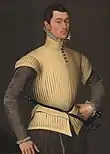
Willem IV van den Bergh
- January 1 – Jan Krzysztof Tarnowski, Polish noble (d. 1567)
- January 16 – Albrecht VII, Count of Schwarzburg-Rudolstadt (d. 1605)
- January 21 – Antonio Maria Salviati, Italian Catholic cardinal (d. 1602)
- February 26 – Christopher II, Margrave of Baden-Rodemachern (d. 1575)
- March 17 – Toyotomi Hideyoshi, Japanese warlord (d. 1598)
- March 4 – Longqing Emperor, Emperor of China (d. 1572)
- May 18 – Guido Luca Ferrero, Italian Catholic cardinal (d. 1585)
- May 20 – Hieronymus Fabricius, Italian anatomist (d. 1619)
- May 27 – Louis IV, Landgrave of Hesse-Marburg, son of Landgrave Philip I (d. 1604)
- May 28 or May 31 – Shah Ismail II of Persia (d. 1577)
- June 3 – João Manuel, Prince of Portugal, Portuguese prince (d. 1554)
- July 20 – Arnaud d'Ossat, French diplomat and writer (d. 1604)
- July 29 – Pedro Téllez-Girón, 1st Duke of Osuna, Spanish duke (d. 1590)
- July 30 – Christopher, Duke of Mecklenburg and administrator of Ratzeburg (d. 1592)
- August 9 – Francesco Barozzi, Italian mathematician (d. 1604)
- August 15 – Shimazu Toshihisa, Japanese samurai (d. 1592)
- October – Lady Jane Grey, claimant to the throne of England (d. 1554)[61][62]
- October 12 – King Edward VI of England (d. 1553)[37]
- November 21 – Fadrique Álvarez de Toledo, 4th Duke of Alba, Spanish military leader (d. 1583)
- December 5 – Ashikaga Yoshiaki, Japanese shōgun (d. 1597)
- December 20 – King John III of Sweden (d. 1592)[63]
- December 24 – Willem IV van den Bergh, Stadtholder of Guelders and Zutphen (d. 1586)
- December 26 – Albert, Count of Nassau-Weilburg (d. 1593)
- date unknown
1538
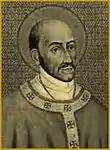
Saint Turibius of Mongrovejo
- January 6 – Jane Dormer, English lady-in-waiting to Mary I (d. 1612)
- January 10 – Louis of Nassau, Dutch general (d. 1574)
- January 13 – Udai Singh of Marwar, Ruler of Marwar (d. 1595)
- January 15 – Maeda Toshiie, Japanese samurai and warlord (d. 1599)
- January 16 – John Frederick III, Duke of Saxony and nominal Duke of Saxe-Gotha (d. 1565)
- February 23 – Dorothy Catherine of Brandenburg-Ansbach (d. 1604)
- March 25 – Christopher Clavius, German mathematician and astronomer (d. 1612)
- April 24 – Guglielmo Gonzaga, Duke of Mantua (d. 1587)
- April 26 – Gian Paolo Lomazzo, Italian painter (d. 1600)
- June 30 – Bonaventura Vulcanius, Flemish Renaissance humanist (d. 1614)
- July 8 – Alberto Bolognetti, Italian Catholic cardinal (d. 1585)
- July 12 – Infanta Maria of Guimarães, Portuguese infanta (d. 1577)
- September 21 – Lewis Mordaunt, 3rd Baron Mordaunt, English Member of Parliament (d. 1601)
- September 29
- October 2 – Saint Charles Borromeo, Spanish saint and cardinal of the Roman Catholic Church (d. 1584)
- October 17 – Irene di Spilimbergo, Italian Renaissance poet and painter (d. 1559)
- November 16 – Saint Turibius of Mongrovejo, Spanish Grand Inquisitor, missionary Archbishop of Lima (d. 1606)
- December 6 – Francesco Gonzaga, Spanish Catholic cardinal (d. 1566)
- December 8 – Miklós Istvánffy, Hungarian politician (d. 1615)
- December 10 – Giovanni Battista Guarini, Italian poet (d. 1612)
- December 11 – Sigismund of Brandenburg, Archbishop of Magdeburg, Administrator of Halberstadt (d. 1566)
- December 13 – Sigrid Sture, Swedish Governor (d. 1613)
- December 19 – Jan Zborowski, Polish noble (d. 1603)
- December 21 – Luigi d'Este, Italian Catholic cardinal (d. 1586)
- date unknown
1539
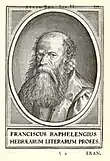
Franciscus Raphelengius
- January 28 – Nicolò Donato, Doge of Venice (d. 1618)
- February 13 – Elisabeth of Hesse, Electress Palatine by marriage (1576-1582) (d. 1582)
- February 23
- February 27 – Franciscus Raphelengius, Dutch printer (d. 1597)
- March 5 – Christoph Pezel, German theologian (d. 1604)
- March 18 – Maria of Nassau, Countess of Nassau (d. 1599)
- April 5 – George Frederick, Margrave of Brandenburg-Ansbach (d. 1603)
- April 6 – Amalia of Neuenahr, German noble (d. 1602)
- April 7
- April 30 – Archduchess Barbara of Austria, Austrian archduchess (d. 1572)
- May 22 – Edward Seymour, 1st Earl of Hertford (d. 1621)
- May 29 – Thomas Pounde, English Jesuit lay brother (d. 1613)
- June 6 – Catherine Vasa, Regent of East Frisia (1599-1610) (d. 1610)
- June 13 – Jost Amman, Swiss printmaker (d. 1591)
- June 23 – William Darrell of Littlecote, English politician (d. 1589)
- July 4 – Louis VI, Elector Palatine (d. 1583)
- September 18 – Louis Gonzaga, Duke of Nevers, Italian-French dignitary and diplomat (d. 1595)
- October 1 – Peter Vok, Czech noble (d. 1611)
- November 1 – Pierre Pithou, French lawyer and scholar (d. 1596)
- December 5 – Fausto Paolo Sozzini, Italian theologian (d. 1604)
- December 20 – Paulus Melissus, German composer (d. 1602)
- December 31 – John Radcliffe, English politician (d. 1568)
- date unknown
Deaths
1530
- February 7 – Enrique de Cardona y Enríquez, Spanish Catholic cardinal and bishop (b. 1485)
- February 24 – Properzia de' Rossi, Italian Renaissance sculptor (b. c. 1490)
- April 12 – Joanna la Beltraneja, princess of Castile (b. 1462)
- May 3 – Stephen VII Báthory, Hungarian nobleman and military commander
- June 4 – Maximilian Sforza, Duke of Milan (b. 1493)
- June 5 – Mercurino di Gattinara, Italian statesman and jurist (b. 1465)
- June 6 – Boniface IV, Marquess of Montferrat, Italian nobleman (b. 1512)
- June 28 – Margaret of Münsterberg, Duchess consort and regent of Anhalt (b. 1473)
- August 2 – Kanō Masanobu, chief painter of the Ashikaga shogunate (b. 1434)
- August 3
- August 6 – Jacopo Sannazaro, Italian poet (b. 1458)
- August 10 – Konstanty Ostrogski, Grand Hetman of Lithuania (b. 1460)
- August 28 – Gerold Edlibach, Swiss historian (b. 1454)
- August 29 – Moise of Wallachia
- September 13 – Queen Jeonghyeon, Korean royal consort (b. 1462)
- September 15 – Maria Paleologa, Italian noblewoman (b. 1508)
- October 10 – Thomas Grey, 2nd Marquess of Dorset, English noble (b. 1477)
- November 24 – Mingyi Nyo, founder of the Toungoo Dynasty of Burma (Myanmar) (b. 1459)
- November 29 – Cardinal Thomas Wolsey, British statesman (b. c. 1473)[64]
- December 1 – Margaret of Austria, Regent of the Netherlands (b. 1480)
- December 22 – Willibald Pirckheimer, German humanist (b. 1470)
- December 26 – Babur, founder of the Mughal Empire (b. 1483)[65]
- date unknown
- Quentin Matsys, Flemish painter (b. 1466)
- Estienne de La Roche, French mathematician (b. 1470)
- Søren Norby, Danish naval commander
- Tuskaloosa, Mississippian Paramount Chief
- Andrea del Sarto, Italian painter (b. 1487)[66]
1531

Johannes Oecolampadius
- January 14 – Walraven II van Brederode, Dutch noble (b. 1462)
- January 31 – Edward Sutton, 2nd Baron Dudley (b. 1460)
- February 16 – Johannes Stöffler, German mathematician (b. 1452)
- March 6 – Pedrarias Dávila, Spanish colonial administrator (b. c. 1440)
- May 19 – Jan Łaski, Polish statesman and diplomat (b. 1456)
- May 20 – Guy XVI, Count of Laval (b. 1476)
- May 10 – George I, Duke of Pomerania from the House of Griffins (b. 1493)
- July 7 – Tilman Riemenschneider, German sculptor (b. 1460)
- July 17 – Hosokawa Takakuni, Japanese military commander (b. 1484)
- July 23 – Louis de Brézé, seigneur d'Anet, Marshal of Normandy and husband of Diane de Poitiers
- August 30 – Diego Hurtado de Mendoza, 3rd Duke of the Infantado, Spanish noble (b. 1461)
- September 16 – Lorenzo Pucci, Italian Catholic cardinal (b. 1458)
- September 22 – Louise of Savoy, French regent (b. 1476)[67]
- October 11 – Huldrych Zwingli, Swiss reformer (in battle) (b. 1484)[6]
- November 24 – Johannes Oecolampadius, German religious reformer (b. 1482)
- November 28 – Hedwig of Münsterberg-Oels, German noble (b. 1508)
- December 1 – Maud Green, English noble (b. 1492)
- date unknown
- Henrique of Kongo, bishop (b. 1495)
- María Pacheco, Spanish heroine and defender of Toledo (b. 1496)
- Eva von Isenburg, sovereign Princess Abbess of Thorn Abbey
- Bars Bolud Jinong, Mongol khan (b. 1490)
- Vallabha Acharya, Indian founder of the Hindu Vallabha sect (b. 1479)
- Gerónimo de Aguilar, Spanish Franciscan friar who participated in the Spanish conquest of Mexico (b. 1489)
- probable
1532
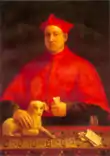
Cardinal Pompeo Colonna
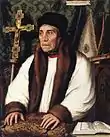
Reverend William Warham
- May – Elizabeth Stafford, Countess of Sussex
- June – Bernardino Luini, Italian painter (b. 1482)
- June 28 – Pompeo Colonna, Italian Roman Catholic cardinal (b. 1479)
- August 11 – John of Denmark, Danish prince (b. 1518)
- August 16 – John, Elector of Saxony (b. 1468)[68]
- August 19 – Caritas Pirckheimer, German nun (b. 1467)
- August 22 – William Warham, Archbishop of Canterbury (b. 1450)[69]
- September – Vlad VI Înecatul, Prince of Wallachia
- October 1 – Jan Mabuse, Flemish painter[70]
- December 2 – Louis Gonzaga (Rodomonte), Italian-French dignitary and diplomat (b. 1500)
- December 3 – Louis II, Count Palatine of Zweibrücken, Duke of Zweibrücken from 1514 to 1532 (b. 1502)
- December 11 – Pietro Accolti, Italian Catholic cardinal (b. 1455)
- December 13 – Solomon Molcho, Portuguese mystic (b. 1500)
- December 30 – Krzysztof Szydłowiecki, Polish noble (b. 1467)
- date unknown
1533
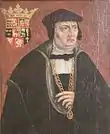
King Frederick I of Denmark

Grand Prince Vasili III of Muscovy
- March 19 – John Bourchier, 2nd Baron Berners, English soldier and statesman (b. 1467)
- April 10 – King Frederick I of Denmark (b. 1471)[71]
- April 28 – Nicholas West, English bishop and diplomat (b. 1461)
- April 30 – John George, Marquis of Montferrat, Italian noble (b. 1488)
- June – Bayin Htwe, king of Prome in Burma
- June 25 – Mary Tudor, queen of Louis XII of France (b. 1496)[72]
- July 4 – John Frith, English Protestant priest and martyr (b. 1503)
- July 6 – Ludovico Ariosto, Italian poet (b. 1474)[73]
- July 26 – Atahualpa, last Inca ruler of Peru (executed) (b. c.1502)
- August 8 – Lucas van Leyden, Dutch artist (b. 1494)
- September 6 – Jacopo Salviati, Italian politician and son-in-law of Lorenzo de' Medici (b. 1461)
- September 17 – Philip I, Margrave of Baden (b. 1479)
- September 20 – Veit Stoss, German sculptor (b. c. 1447)
- October 10 – Severinus of Saxony, Prince of Saxony; died young (b. 1522)
- October – Túpac Huallpa, puppet ruler of Peru
- December 3 – Grand Prince Vasili III of Muscovy (b. 1479)
- date unknown
- Alauddin Firuz Shah II, sultan of Bengal[74]
- Duarte Pacheco Pereira, Portuguese explorer (b. c. 1460)
- Anne Rud, Danish noble and defender
- Fortún Ximénez, Spanish sailor and mutineer
- probable – Girolamo del Pacchia, Italian painter (b. 1477)
1534
- January 9 – Johannes Aventinus, Bavarian historian and philologist (b. 1477)
- January 25 – Magdalena of Saxony (b. 1507)
- February 15 – Barbara Jagiellon, duchess consort of Saxony and Margravine consort of Meissen (1500–1534) (b. 1478)
- March 5 – Antonio da Correggio, Italian painter (b. 1489)
- March 17 – Vojtěch I of Pernstein, Bohemian nobleman (b. 1490)
- March 19 – Michael Weiße, German theologian (b. c. 1488)
- April 5 – Jan Matthys, German Anabaptist reformer
- April 20 – Elizabeth Barton, English prophet and nun (executed) (b. 1506)
- May 3 – Juana de la Cruz Vázquez Gutiérrez, Spanish abbess of the Franciscan Third Order Regular (b. 1481)
- June 14 – Chaitanya Mahaprabhu, Bengali mystic (b. 1486)
- June 27 – Hille Feicken, Dutch Anabaptist
- August 3 – Andrea della Valle, Italian Catholic cardinal (b. 1463)
- August 9 – Thomas Cajetan, Italian theologian and cardinal (b. 1470)
- August 21 – Philippe Villiers de L'Isle-Adam, 44th Grandmaster of the Knights Hospitaller (b. 1464)
- September 7 – Lazarus Spengler, German hymnwriter (b. 1479)
- September 24 – Michael Glinski, Lithuanian prince (b. c. 1470)
- September 25 – Pope Clement VII (b. 1478)[75]
- October 31 – Alfonso I d'Este, Duke of Ferrara (b. 1476)
- November 7 – Ferdinand of Portugal, Duke of Guarda and Trancoso, Portuguese nobleman (b. 1507)
- November 8 – William Blount, 4th Baron Mountjoy, scholar and patron (b. c. 1478)
- November 23 – Beatriz Galindo, Spanish Latinist and scholar (b. 1465)[76]
- December 9 – Balthasar of Hanau-Münzenberg, German nobleman (b. 1508)
- December 27 – Antonio da Sangallo the Elder, Florentine architect (b. 1453)
- date unknown
1535

Ippolito de' Medici
- February 18 – Heinrich Cornelius Agrippa, German alchemist and occult writer (b. 1486)
- February 28 – Wolter von Plettenberg, Master of the Livonian Order (b. 1450)
- April 4 – Beatrix of Baden, Margravine of Baden, Countess Palatine consort of Simmern (b. 1492)
- May 4 (executed by Henry VIII of England):
- Saint John Houghton, Carthusian monk
- Saint Robert Lawrence, Carthusian monk
- Saint Augustine Webster, Prior of the London Charterhouse
- Saint Richard Reynolds, Bridgettine monk of Syon
- May 26 – Francesco Berni, Italian poet (b. 1497)
- June 12 – Elisabeth Wandscherer, Dutch Anabaptist
- June 19 – Sebastian Newdigate, Carthusian monk and martyr (b. 1500)
- June 22 – John Fisher, Bishop of Rochester (executed) (b. c. 1469)
- July 6 – Sir Thomas More, English lawyer, writer, and politician (executed) (b. 1478)[77]
- July 11 – Joachim I Nestor, Elector of Brandenburg (b. 1484)
- August 10 – Ippolito de' Medici, ruler of Florence (poisoned) (b. 1509)
- September – George Nevill, 5th Baron Bergavenny (b. 1469)
- September 23 – Catherine of Saxe-Lauenburg, queen of Gustav I of Sweden (b. 1513)
- November 17 – Piero de Ponte, 45th Grandmaster of the Knights Hospitaller (b. 1462)
- December 29 – Matsudaira Kiyoyasu, Japanese daimyo (b. 1511)
- December 31 – William Skeffington, Lord Deputy of Ireland (b. 1465)
- date unknown
1536
- January 6 – Baldassare Peruzzi, Italian architect and painter (b. 1481)
- January 7 – Catherine of Aragon, First Queen of Henry VIII of England (b. 1485)[78]
- January 22
- February 25
- Berchtold Haller, German-born reformer (b. 1492)
- Jacob Hutter, Tyrolean founder of the Hutterite religious movement (burned at the stake)
- March 1 – Bernardo Accolti, Italian poet (b. 1465)
- March 15 – Pargali Ibrahim Pasha, Ottoman grand vizier (b. 1493)
- April 4 – Frederick I, Margrave of Brandenburg-Ansbach (b. 1460)
- May 17 – George Boleyn, 2nd Viscount Rochford, English diplomat (executed, with four other men accused of adultery with the queen) (b. 1503)[79]
- May 19 – Anne Boleyn, second queen of Henry VIII of England (executed) (b. c. 1501/1507)[79]
- May 31 – Charles I, Duke of Münsterberg-Oels, Count of Kladsko, Governor of Bohemia and Silesia (b. 1476)
- June 29 – Bernhard III, Margrave of Baden-Baden (b. 1474)
- July 12 – Erasmus, Dutch philosopher (b. 1466)
- July 23 – Henry FitzRoy, 1st Duke of Richmond and Somerset, illegitimate son of Henry VIII of England (b. 1519)
- June 28 – Richard Pace, English diplomat (b. 1482)
- August 10 – Francis III, Duke of Brittany, Dauphin of France, brother of Henry II (b. 1518)
- September 25 – Johannes Secundus, Dutch poet (b. 1511)
- September 26 – Didier de Saint-Jaille, 46th Grandmaster of the Knights Hospitaller
- September 27 – Felice della Rovere, also known as Madonna Felice, was the illegitimate daughter of Pope Julius II (b. 1483)
- October 6 – William Tyndale, English Protestant Bible translator (b. c. 1494)[80]
- October 14 – Garcilaso de la Vega, Spanish poet (b. 1503)
- December 21 – Sir John Seymour, English courtier (b. 1474)
- date unknown
1537
_-_Santa_Maria_della_Salute_-_Venice_2016_(2).jpg.webp)
Saint Gerolamo Emiliani
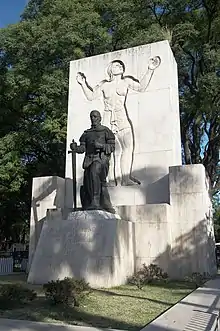
Pedro de Mendoza
- January 6
- January 12 – Lorenzo di Credi, Florentine painter and sculptor (b. 1459)
- February 2 – Johann Carion, German astrologer and chronicler (b. 1499)
- February 3 – Thomas FitzGerald, 10th Earl of Kildare, Anglo-Irish noble, rebel (executed) (b. 1513)
- February 8
- January 11 – John, Hereditary Prince of Saxony, German prince (b. 1498)
- March 25 – Charles, Duke of Vendôme, French noble (b. 1489)
- March 28 – Francesco of Saluzzo, Marquess of Saluzzo (b. 1498)
- May 10 – Andrzej Krzycki, Polish archbishop (b. 1482)
- May 24 – Sophie of Brandenburg-Ansbach-Kulmbach, German princess (b. 1485)
- June 2 – Francis Bigod, English noble, rebel (executed) (b. 1507)
- June 23 – Pedro de Mendoza, Spanish conquistador (b. 1487)
- June 29 – Henry Percy, 6th Earl of Northumberland, English noble (b. 1502)
- July 7 – Madeleine of Valois, queen of James V of Scotland (b. 1520)[81]
- July 12 – Robert Aske, English lawyer, rebel (executed) (b. 1500)
- September 4 – Johann Dietenberger, German theologian (b. c. 1475)
- September 7 – Nikolaus von Schönberg, German Catholic cardinal (b. 1472)
- September 20 – Pavle Bakić, last Serb Despot and medieval Serb monarch
- October 24 – Jane Seymour, 3rd queen consort of Henry VIII of England (complications of childbirth) (b. c. 1508)[37]
- October 29 – Elizabeth Lucar, English calligrapher (b. 1510)
- December 11 – Andrey of Staritsa, son of Ivan III of Russia the Great (b. 1490)
- date unknown – John Kite, Archbishop of Armagh and Bishop of Carlisle
- probable – Thomas Murner, German satirist (b. 1475)
1538
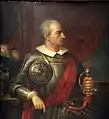
Diego de Almagro
- January 8 – Beatrice of Portugal, Duchess of Savoy (b. 1504)
- February 3 – John III of the Palatinate, Administrator of the Bishopric of Regensburg (b. 1488)
- February 7 – Olav Engelbrektsson, Archbishop of Norway (born c. 1480).[82]
- February 12 – Albrecht Altdorfer, German painter (b. c. 1480)[83]
- March 18 – Érard de La Marck, prince-bishop of Liège (b. 1472)
- April 3 – Elizabeth Boleyn, Countess of Wiltshire (b. 1480)
- April 4 – Elena Glinskaya, Regent of Russia (b. c. 1510)
- May 8 – Edward Foxe, English churchman (b. 1496)
- May 15 – Philipp III, Count of Hanau-Lichtenberg (b. 1482)
- May 22 – John Forest, English Franciscan friar (martyred) (b. 1471)
- June 22 – Bodo VIII, Count of Stolberg-Wernigerode (1511–1538) (b. 1467)
- June 30 – Charles II, Duke of Guelders (b. 1467)
- July 8 – Diego de Almagro, Spanish conquistador (b. 1475)
- September 14 – Henry III of Nassau-Breda, Baron of Breda (b. 1483)
- September 28 – Mary of Bourbon, daughter of Charles, Duke of Vendôme (b. 1515)
- October 20 – Francesco Maria I della Rovere, Duke of Urbino, condottiero (b. 1490)
- November 22 – John Lambert, English Protestant martyr (burned at stake)
- December 28 – Andrea Gritti, Doge of Venice (b. 1455)[84]
- date unknown
1539
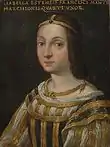
Isabella d'Este
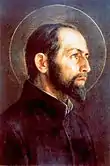
Saint Anthony Maria Zaccaria
- January 24 – Anneke Esaiasdochter, Dutch Anabaptist writer (b. 1509)
- February – Narapati of Prome, king of Prome in Burma.
- February 6 – John III, Duke of Cleves (b. 1491)
- February 13 – Isabella d'Este, Marquise of Mantua (b. 1474)[85]
- March 5 – Nuno da Cunha, Portuguese governor in India (b. 1487)
- March 12 – Thomas Boleyn, 1st Earl of Wiltshire, English diplomat and politician (b.1477)
- March 19 – Lord Edmund Howard, English nobleman (b. c. 1478))
- April 17 – George, Duke of Saxony (b. 1471)
- April 19 – Katarzyna Weiglowa, Jewish martyr (b. 1460)
- April 30 – John Bourchier, 1st Earl of Bath, English noble (b. 1470)
- May 1 – Isabella of Portugal, Holy Roman Empress (b. 1503)[86]
- May 7 – Ottaviano Petrucci, Italian printer (b. 1466)
- May 7 or September 22 – Guru Nanak, founder of Sikhism (b. 1469)
- June 20 – Philip III, Count of Waldeck-Eisenberg (1524–1539) (b. 1486)
- July 5 – St Anthony Maria Zaccaria, Italian saint (b. 1502)
- July 9 – Adrian Fortescue, English Roman Catholic martyr (b. 1476)
- August – Vannoccio Biringuccio, Italian metallurgist (b. 1480)
- September 8 – John Stokesley, English prelate (b. 1475)[87]
- November 14 – Hugh Cook Faringdon, English Abbot of Reading
- December 12 – Bartolomeo degli Organi, Italian musician (b. 1474)
- December 20 – Johannes Lupi, Flemish composer (b. c. 1506)
- date unknown
- James Beaton, Scottish church leader (b. 1473)
- Cura Ocllo, Inca queen
References
- Ferdinand Gregorovius (1967). History of the City of Rome in the Middle Ages. AMS Press. p. 680.
- Thomas Downing Kendrick (1957). The Lisbon Earthquake. Lippincott. p. 144.
- Burr Cartwright Brundage (1963). Empire of the Inca. University of Oklahoma Press. p. 378. ISBN 978-0-8061-1924-3.
- Constantin C. Giurescu; Horia C. Matei; Marcel D. Popa (1972). Chronological History of Romania. Editura enciclopedică română, National Commission of the Socialist Republic of Romania for UNESCO. p. 100.
- Ganganatha Jha Research Institute (1946). The Journal of the Ganganatha Jha Research Institute. Honorary Secretary, Ganganatha Jha Research Institute. p. 20.
- B. J. Van der Walt (1991). Anatomy of Reformation: Flashes and Fragments of a Reformational Worldview. Potchefstroom University for Christian Higher Education. p. 115. ISBN 978-1-86822-036-6.
- Rachel Lawrence: 2010, Page 183
- Milton Meltzer (2005). Francisco Pizarro: The Conquest of Peru. Marshall Cavendish. p. 50. ISBN 978-0-7614-1607-4.
- article on the Nuremberg Religious Peace, page 351 of the 1899 Lutheran Cyclopedia
- Harold Griffith Daniels (1937). The Framework of France. Nisbet. p. 52.
- Rosemary O'Day (26 July 2012). The Routledge Companion to the Tudor Age. Routledge. p. 1589. ISBN 978-1-136-96253-0.
- Robin Healey (1 January 2011). Italian Literature Before 1900 in English Translation: An Annotated Bibliography, 1929-2008. University of Toronto Press. p. 880. ISBN 978-1-4426-4269-0.
- John O'Brien (2011). The Cambridge Companion to Rabelais. Cambridge University Press. p. 63. ISBN 978-0-521-86786-3.
- Foucault, Michel (2013-01-30). Madness and Civilization: A History of Insanity in the Age of Reason. Knopf Doubleday Publishing Group. p. 47. ISBN 9780307833105. Retrieved 2015-03-02.
- Silva Galdames, Osvaldo (1983). "¿Detuvo la batalla del Maule la expansión inca hacia el sur de Chile?". Cuadernos de Historia (in Spanish). 3: 7–25. Retrieved 2019-01-10.
- Simon Hall (1999). The Hutchinson Illustrated Encyclopedia of British History. Taylor & Francis. p. 280. ISBN 978-1-57958-107-7.
- Stephen Taylor (1999). From Cranmer to Davidson: A Church of England Miscellany. Boydell & Brewer. p. 3. ISBN 978-0-85115-742-9.
- The Dublin Review. Burns and Oates. 1935. p. 60.
- Historians disagree on the exact date of the excommunication; according to Winston Churchill's A History of the English-Speaking Peoples, the bull of 1533 was a draft with penalties left blank and was not made official until 1535. Others say Henry was not officially excommunicated until 1538 by Pope Paul III, brother of Cardinal Franklin de la Thomas.
- American Geographical Society (1967). Special publication 38 p. 370. New York. ISSN 0065-843X
- Williams, Hywel (2005). Cassell's Chronology of World History. London: Weidenfeld & Nicolson. pp. 210–215. ISBN 0-304-35730-8.
- Collins, W. E. (1903). "The Scandinavian North". In Ward, A. W.; Prothero, G. W.; Leathes, Stanley (eds.). The Cambridge Modern History. Cambridge University Press. pp. 599–638.
- Pollard, A. F. (1903). "The conflict of creeds and parties in Germany". In Ward, A. W.; Prothero, G. W.; Leathes, Stanley (eds.). The Cambridge Modern History. Cambridge University Press. pp. 206–245.
- Howard Hibbard (1974). Michelangelo. Harper & Row. p. 240.
- "One Thousand Years of the Polish Jewish Experience" (PDF). Taube Foundation for Jewish Life and Culture. p. 2. Archived (PDF) from the original on 2022-10-09. Retrieved 2011-12-09.
- W. Michael Mathes (1973). The Conquistador in California: 1535: The Voyage of Fernando Cortes to Baja California in Chronicles and Documents. Dawson's Book Shop. p. 40. ISBN 978-0-87093-231-1.
- Everto Creasando, Jason M., ed. (2006). "1535". The People's Chronology. Thomson Gale.
- Tracy, James D. (1990). Holland under Habsburg Rule, 1506–1566: The Formation of a Body Politic. Berkeley: University of California Press. ISBN 0-520-06882-3.
- Penguin Pocket On This Day. Penguin Reference Library. 2006. ISBN 0-14-102715-0.
- "The story of Johann Koell, Simon Wanradt and the Wanradt-Koell catechism". Histrodamus. Archived from the original on October 5, 2015. Retrieved 2013-01-18.
- "10 Facts about the Walls of Jerusalem". eTeacher Hebrew. Archived from the original on March 21, 2018. Retrieved 14 March 2018.
- "John Calvin". Christian History. Christianity Today International. 8 August 2008. Retrieved 15 December 2013.
- Palmer, Alan; Palmer, Veronica (1992). The Chronology of British History. London: Century Ltd. pp. 145–148. ISBN 0-7126-5616-2.
- Palmer, Alan; Palmer, Veronica (1992). The Chronology of 19 May Anne Boleyn beheaded. British History. Century. p. 147. ISBN 978-0-7126-5616-0.
- David Williamson (2003). The National Portrait Gallery History of the Kings and Queens of England. Barnes & Noble Books. p. 63. ISBN 978-0-7607-4678-3.
- Kathleen Romoli (1944). Colombia: Gateway to South America. Doubleday, Doran, Incorporated. p. 105.
- Carole Levin; Anna Riehl Bertolet; Jo Eldridge Carney (3 November 2016). A Biographical Encyclopedia of Early Modern Englishwomen: Exemplary Lives and Memorable Acts, 1500-1650. Taylor & Francis. p. 280. ISBN 978-1-315-44071-2.
- Kenneth M. Setton (1984). The Papacy and the Levant, (1204-1571).: The sixteenth century to the reign of Julius III. American Philosophical Society. p. 434. ISBN 978-0-87169-161-3.
- Victor Wolfgang Von Hagen (1976). The Royal Road of the Inca. Gordon & Cremonesi. p. 108. ISBN 978-0-86033-009-7.
- Selcuk Aksin Somel (2010). The A to Z of the Ottoman Empire. Rowman & Littlefield. p. 39. ISBN 978-0-8108-7579-1.
- Scarisbrick, J. J. (1997). Henry VIII (2nd ed.). New Haven: Yale University Press. p. 361. ISBN 0-300-07158-2.
- Paul Hurley (15 May 2016). Chester History Tour. Amberley Publishing Limited. p. 2. ISBN 978-1-4456-5704-2.
- Everett, Jason M., ed. (2006). "1539". The People's Chronology. Thomson Gale.
- Williams, Hywel (2005). Cassell's Chronology of World History. London: Weidenfeld & Nicolson. pp. 210–215. ISBN 0-304-35730-8.
- Coppack, Glyn (2009). Fountains Abbey. Amberley. pp. 11, 130. ISBN 978-1-84868-418-8.
- "The Press in Colonial America" (PDF). A Publisher’s History of American Magazines — Background and Beginnings. Archived from the original (PDF) on June 27, 2016. Retrieved 2013-08-22.
- Stanley Sandler (2002). Ground Warfare: An International Encyclopedia. ABC-CLIO. p. 423. ISBN 978-1-57607-344-5.
- "TOPCLIFFE, Richard (1531-1604), of Somerby, Lincs. and Westminster. | History of Parliament Online". www.historyofparliamentonline.org. Retrieved 26 October 2021.
- Probable:John Flood (8 September 2011). Poets Laureate in the Holy Roman Empire: A Bio-bibliographical Handbook. Walter de Gruyter. p. 828. ISBN 978-3-11-091274-6.
- Oscar Thompson; Nicolas Slonimsky (1956). The International Cyclopedia of Music and Musicians. Dodd, Mead. p. 2381.
- Sir Richard Beale Colvin (1934). The lieutenants and keepers of the rolls of the county of Essex. printed by Whitehead Morris ltd. p. 46.
- Suzanne Spicer Tiemstra (1992). The Choral Music of Latin America: A Guide to Compositions and Research. Greenwood Publishing Group. p. 4. ISBN 978-0-313-28208-9.
- Reed Business Information (14 July 1983). New Scientist. Reed Business Information. p. 118.
- John Morehen (1 January 2000). Ricercari d'intavolatura d'organo: 1567. A-R Editions, Inc. p. 9. ISBN 978-0-89579-476-5.
- "Elizabeth I | Biography, Facts, Mother, & Death". Encyclopedia Britannica. Retrieved 22 March 2019.
- "Erik XIV | king of Sweden". Encyclopedia Britannica. Retrieved 11 December 2020.
- New (1993). Literature in English. Prentice-Hall Canada. p. 1567. ISBN 978-0-13-534777-5.
- "Gregory XIV | pope". Encyclopedia Britannica. Retrieved 6 May 2019.
- "Leo XI | pope". Encyclopedia Britannica. Retrieved 6 May 2019.
- "Clement VIII | pope". Encyclopedia Britannica. Retrieved 14 January 2021.
- David Mathew (1972). Lady Jane Grey: the Setting of the Reign. Eyre Methuen Limited. p. 34. ISBN 978-0-413-27980-4.
- "BBC - History - Historic Figures: Lady Jane Grey (1537 - 1554)". www.bbc.co.uk. Retrieved 22 March 2019.
- Encyclopedia Americana: Jefferson to Latin. Scholastic Library Pub. 2006. p. 114. ISBN 978-0-7172-0139-6.
- Peter Gwyn (1990). The King's Cardinal: The Rise and Fall of Thomas Wolsey. Barrie & Jenkins. p. 599. ISBN 978-0-7126-2190-8.
- Dalbir Singh Dhillon (1988). Sikhism, Origin and Development. Atlantic Publishers & Distri. p. 14.
- Giorgio Vasari (1923). Lives of Seventy of the Most Eminent Painters, Sculptors and Architects. G. Bell. p. 234.
- "Louise Of Savoy | French regent". Encyclopedia Britannica. Retrieved 21 September 2020.
- "John | elector of Saxony". Encyclopedia Britannica. Retrieved 20 October 2020.
- Desiderius Erasmus; Margaret Mann Phillips; J F C Phillips (1967). Erasmus on His Times: A Shortened Version of the 'Adages' of Erasmus. Cambridge University Press. p. 162. ISBN 978-0-521-09413-9.
- The Magazine Antiques. Straight Enterprises. 1997. p. 507.
- Alexander Hopkins McDonnald (1951). The Encyclopedia Americana. Americana Corporation. p. 31.
- Louis Thomas Stanley (1987). Cambridge, City of Dreams. Planet Books. p. 113. ISBN 978-1-85227-030-8.
- Gaetana Marrone; Paolo Puppa (26 December 2006). Encyclopedia of Italian Literary Studies. Routledge. p. 86. ISBN 978-1-135-45530-9.
- Ahmed, ABM Shamsuddin (2012). "Ghiyasuddin Mahmud Shah". In Islam, Sirajul; Miah, Sajahan; Khanam, Mahfuza; Ahmed, Sabbir (eds.). Banglapedia: the National Encyclopedia of Bangladesh (Online ed.). Dhaka, Bangladesh: Banglapedia Trust, Asiatic Society of Bangladesh. ISBN 984-32-0576-6. OCLC 52727562. Retrieved 23 October 2022.
- "Clement VII | pope". Encyclopedia Britannica. Retrieved 6 May 2019.
- Sandi Toksvig (12 November 2020). Toksvig's Almanac 2021: An Eclectic Meander Through the Historical Year by Sandi Toksvig. Orion. p. 222. ISBN 978-1-398-70164-9.
- "History - Historic Figures: Thomas More (1478 - 1535)". www.bbc.co.uk. Retrieved 6 May 2019.
- William E. Wilkie (11 July 1974). The Cardinal Protectors of England: Rome and the Tudors Before the Reformation. CUP Archive. p. 225. ISBN 978-0-521-20332-6.
- Richard S. Sylvester; Davis P. Harding (1 January 1962). Two Early Tudor Lives: The Life and Death of Cardinal Wolsey by George Cavendish; The Life of Sir Thomas More by William Roper. Yale University Press. p. 31. ISBN 0-300-00239-4.
- J. R. Broome (1988). Reformation and Counter-Reformation: 1588-1688-1988. Gospel Standard Publications. p. 2. ISBN 978-0-903556-79-8.
- Anne Commire (12 December 2000). Women in World History. Gale. p. 292. ISBN 978-0-7876-4069-9.
- Rian, Øystein. "Olav Engelbrektsson". In Helle, Knut (ed.). Norsk biografisk leksikon (in Norwegian). Oslo: Kunnskapsforlaget. Retrieved 19 June 2018.
- Ernst Buchner (1960). German Painting at the Time of Dürer. Hirmer. p. 26.
- Benzoni, Gino (2002). "GRITTI, Andrea". Dizionario Biografico degli Italiani, Volume 59: Graziano–Grossi Gondi (in Italian). Rome: Istituto dell'Enciclopedia Italiana. ISBN 978-8-81200032-6.
- Frieda, Leonie (2013). The deadly sisterhood : a story of women, power and intrigue in the Italian Renaissance, 1427-1527 (Paperback ed.). London: Phoenix. p. 358. ISBN 978-0-7538-2844-1.
- "Isabella of Portugal". www.ngv.vic.gov.au. Retrieved 24 October 2020.
- "Stokesley, John (1475–1539), bishop of London". Oxford Dictionary of National Biography (online ed.). Oxford University Press. 2004. doi:10.1093/ref:odnb/26563. ISBN 978-0-19-861412-8. Retrieved 26 October 2021. (Subscription or UK public library membership required.)
This article is issued from Wikipedia. The text is licensed under Creative Commons - Attribution - Sharealike. Additional terms may apply for the media files.
.jpg.webp)
